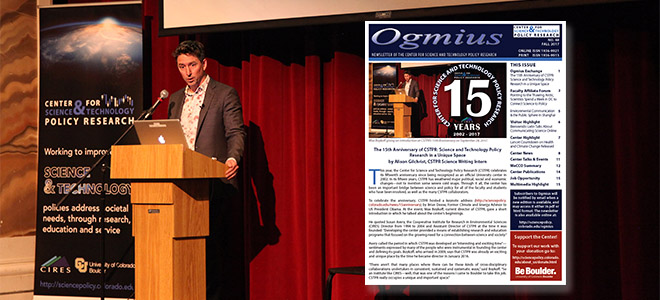
Ogmius
Issue #48, Fall 2017
The 15th Anniversary of CSTPR: Science and Technology Policy Research in a Unique Space
This year, the Center for Science and Technology Policy Research (CSTPR) celebrates its fifteenth anniversary since being recognized as an official University center in 2002. In its fifteen years, CSTPR has weathered major political, social and economic changes—not to mention some severe cold snaps. Through it all, the center has been an important bridge between science and policy for all of the faculty and students who have been involved, as well as the many CSTPR collaborators.
To celebrate the anniversary, CSTPR hosted a keynote address by Brian Deese, Former Climate and Energy Advisor to US President Obama. At the event, Max Boykoff, current director of CSTPR, gave a short introduction in which he talked about the center’s beginnings.
He quoted Susan Avery, the Cooperative Institute for Research in Environmental Sciences (CIRES) Director from 1994 to 2004 and Assistant Director of CSTPR at the time it was founded: “Developing the center provided a means of establishing research and education programs that focused on the growing need for a connection between science and society.”
Avery called the period in which CSTPR was developed an “interesting and exciting time”—sentiments expressed by many of the people who were instrumental in founding the center and defining its goals. Boykoff, who arrived in 2009, says that CSTPR was already an exciting and unique place by the time he became director in January 2016.
“There aren’t that many places where there can be these kinds of cross-disciplinary collaborations undertaken in consistent, sustained and systematic ways,” said Boykoff. “So an institute like CIRES—well, that was one of the reasons I came to Boulder to take this job. CSTPR really occupies a unique and important space.” Read more …
Pointing to the Thawing Arctic, Scientists Spend a Week in Washington, DC to Connect Science to PolicY by Matthew Druckenmiller
The Arctic is warming twice as fast as the rest of the world, with implications spanning all defining characteristics: sea ice, land ice, permafrost, and cold-adapted communities and ecosystems. The observed changes in the Arctic are resounding, the resulting connections to the globe are increasingly clear, and the science community has a clear role to play in supporting action.
The Arctic has experienced the 11 lowest observed summer sea ice extents, all within the last 11 years. At the end of summer, Arctic sea ice today is a mere 60% of the area it covered just 40 years ago, and less than 40% of the volume. A new ocean is emerging, transforming fisheries, ecosystems, and transportation corridors. Governments, industries, and conservationists are struggling to keep pace, scrambling for the best and latest science and observations. There is also growing evidence that diminishing Arctic sea ice leads to a weaker, meandering jet stream over North America, which in turn can be linked to unusually persistent weather patterns and unfamiliar storm tracks, such as those observed during hurricanes Sandy and Harvey. These storms brought remarkable devastation to the Northeast U.S. and Houston, Texas, respectively, while sparking policymakers’ and the public’s attention toward the potential drivers of such events.
But there are also the hidden and slow creeping effects of amplified warming in the Arctic. Carbon trapped in northern permafrost (the remains of un-decomposed organic matter from thousands of years ago) equates to 1500 petagrams of carbon, equivalent to approximately twice the carbon currently in the atmosphere. As permafrost—persistently frozen ground—thaws, we may expect 1 petragram of additional carbon released annually to the atmosphere (~ 1/10 of global fossil fuel emissions). This is a critical positive feedback of the global climate system, and perhaps the best example of the now common refrain from the science community: “What happens in the Arctic doesn’t stay in the Arctic”. Read more …
Environmental Communication and the Public Sphere in Shanghai by Phaedra Pezzullo
In October, I traveled to Fudan University in Shanghai, China, to co-teach a course in environmental communication. The invitation was extended, in part, because I coauthored a textbook with three-time Sierra Club President and Emeritus Professor Robert Cox, Environmental Communication and the Public Sphere (fifth edition forthcoming). I gave three lectures: Western conceptions of the public sphere; Science and risk communication; and Environmental and climate justice movements.
When we address communication and social change, context matters. In the US, democratic rights related to environmental policy are under attack: the right to know has diminished as the current administration has removed data from government websites (for example, the removal of climate data and civil rights information) and there appears to be an endless list of rolled back environmental protections (for example, these 23 regulations removed in the first 100 days). Despite the devastating impacts of neoliberal US policy, most of us hold on to democracy as an ideal driving our engagement in networked public spheres, which shape government decision-making about public goods. Yet, democracy isn’t the only system of governance for environmental action.
Like the US, there is no lack of Chinese ecological and human rights challenges. In terms of an energy transition, however, China is exceeding the US in most ways without appealing to democratic ideals. China’s solar boom is perhaps most astonishing, installing “more than 34 gigawatts of solar capacity in 2016 – more than double the figure for the US and nearly half of the total added capacity worldwide that year.” Read more …
Bienvenido León Talks About Communicating Science Online: Are You Not Infotained?
Bienvenido León watches scientific online videos with an objective, critical eye. Many of us click through to a video about climate change because the penguin in the thumbnail image is totally adorable, and return to Facebook five minutes later without thinking about what compelled us to watch the video all the way through. León, in contrast, thinks about why you stayed to watch.
León is a visiting professor from the University of Navarra, in Spain, where he studies audio-visual science and environment communication. In particular, he’s interested in how climate change is being addressed with online videos. He is currently teaching a class at the CIRES Center for Science and Technology Policy Research (CSTPR) called “How to Effectively Represent Climate Change in a 21st Century Multi-Media World.”
León described pluses and minuses about the rise of online videos on climate change. On one hand, he admires the innovation of organizations that are using the internet to reach (and teach) new viewers.
“Traditional players, the so-called “legacy media”, are doing the same thing that they did on TV,” said León. “They’re trying to adapt, but they are still very into what they used to do. New players such as Buzzfeed or Vice News are doing something very different to attract young people.”
But on the other hand, León recognizes that the trend is towards short and light “infotainment,” not always a good medium for relaying all of the background and facts of a complicated scientific topic. Read more …
View Full Issue




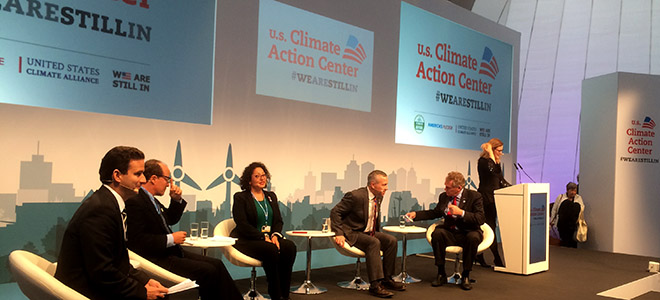
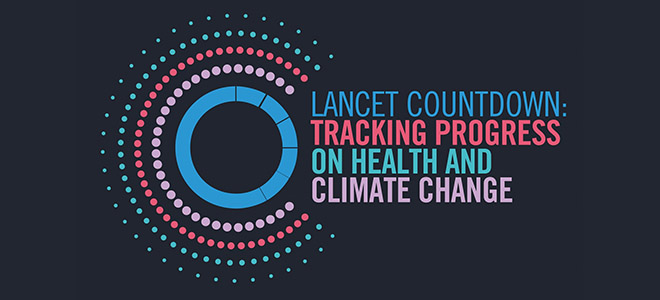

 Science and Technology Policy Theme and Drivers of Risk Management Decisions Theme
Science and Technology Policy Theme and Drivers of Risk Management Decisions Theme Innovations in Governance and Sustainability Theme
Innovations in Governance and Sustainability Theme Science and Technology Policy Theme and Drivers of Risk Management Decisions Theme
Science and Technology Policy Theme and Drivers of Risk Management Decisions Theme Communication and Societal Change Theme
Communication and Societal Change Theme
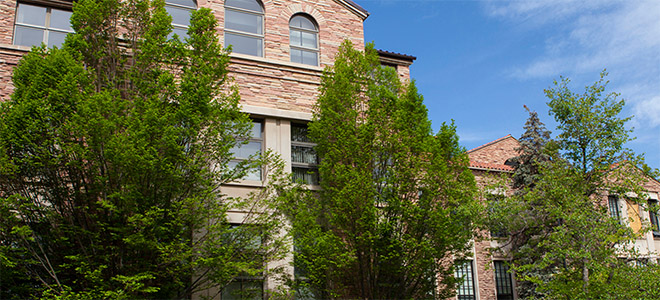
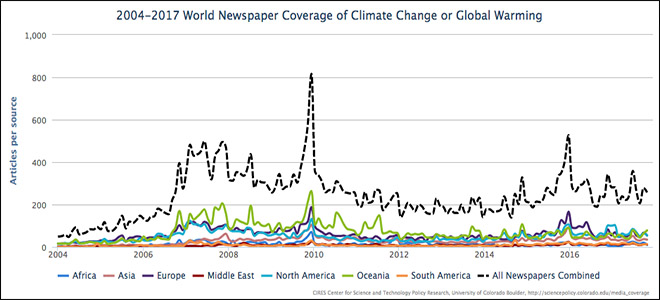
 Figure 3 shows word frequency data in the United States (top left), Canada (top right), Australia (bottom left) and India (bottom right) in October 2017. The five representative US sources are The Washington Post, The Wall Street Journal, The New York Times, USA Today, and the Los Angeles Times. The three representative Canadian sources are The Globe & Mail, The National Post and the Toronto Star. The five representative Australian sources are The Age, The Australian, The Courier Mail, The Daily Telegraph & Sunday Telegraph and The Sydney Morning Herald. The four representative Indian sources are The Hindu, The Times of India, Hindustan Times and The Indian Express.
Figure 3 shows word frequency data in the United States (top left), Canada (top right), Australia (bottom left) and India (bottom right) in October 2017. The five representative US sources are The Washington Post, The Wall Street Journal, The New York Times, USA Today, and the Los Angeles Times. The three representative Canadian sources are The Globe & Mail, The National Post and the Toronto Star. The five representative Australian sources are The Age, The Australian, The Courier Mail, The Daily Telegraph & Sunday Telegraph and The Sydney Morning Herald. The four representative Indian sources are The Hindu, The Times of India, Hindustan Times and The Indian Express.
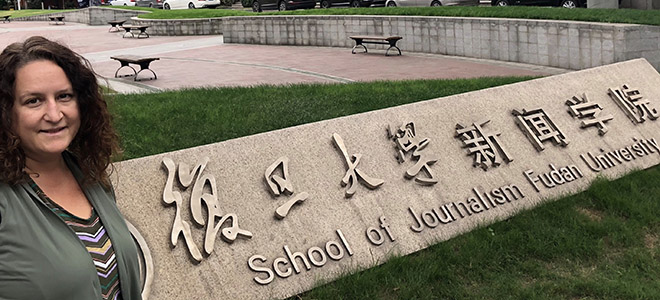
Hot Topics at COP 23
by Diana Dorman
Environmental Studies Program, University of Colorado Boulder
The main body of the United Nations Framework Convention on Climate Change (UNFCCC) meets every year for the Conference of Parties (COP) to discuss and negotiate measures to combat climate change. The 23rd meeting of the COP took place Nov 6-17 in Bonn, Germany. The COP is where global agreements such as the Kyoto Protocol and the Paris Agreement have been created and signed by countries around the world. Every COP has different challenges and themes as the effects of climate change become more apparent and circumstances change in individual countries. This COP was no different, and as a Master’s student in the Environmental Studies program I was able to observe COP 23 and several of the hot topics relevant this year.
Small Island States Front and Center
COP 23 was the first to be led by a small island develop state (SIDS), putting their issues regarding climate change front and center. Fiji’s Presidency at COP 23 reminded the world that for those in Melanesia, Micronesia and Polynesia the effects of climate change are here and disrupting entire communities. I sat in on several panels that discussed full community relocation due to sea walls no longer stopping the relentless waves, or because water sources and farmland had been corrupted by sea water encroachment. Fiji called for the global community to notice the issues of the SIDS and take action before it is too late.
Gender Equality and Climate Change
Climate change impacts are expected to hit disadvantaged groups hardest, including women. Women tend to make less than men and have more restricted access to technology and financial resources to counter challenges caused by climate change. The Paris Agreement incorporates language requiring that equality and aiding disadvantaged groups is pursued moving forward to combat climate change. Acknowledging this issue and continuing these conversations on a global stage is an encouraging first step to progress the issue of gender equality.
The USA at COP 23
After being a leading force in 2015 on the Paris Agreement the United States’ position on climate change has taken a 180-degree turn. The election of President Trump swiftly brought in the US intention to withdraw from the Paris Agreement. The United States did not have an official delegation or pavilion at COP 23, but the citizen and business community of the US did at in the U.S. Climate Action Center where “We are still in” was the tagline. Conversations around US actions seemed to express disappointment and frustration, but also resolve to trudge on and continue progress on climate change without America.